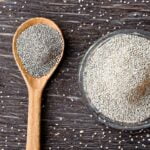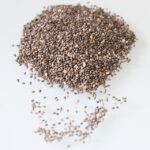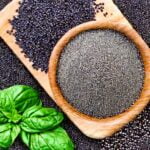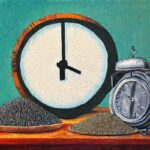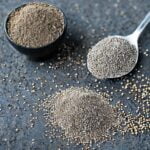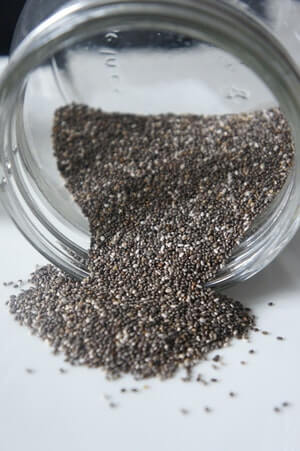This post will be a complete and ultimate chia seeds guide! I’ll try to cover all the major topics concerning chia seeds.
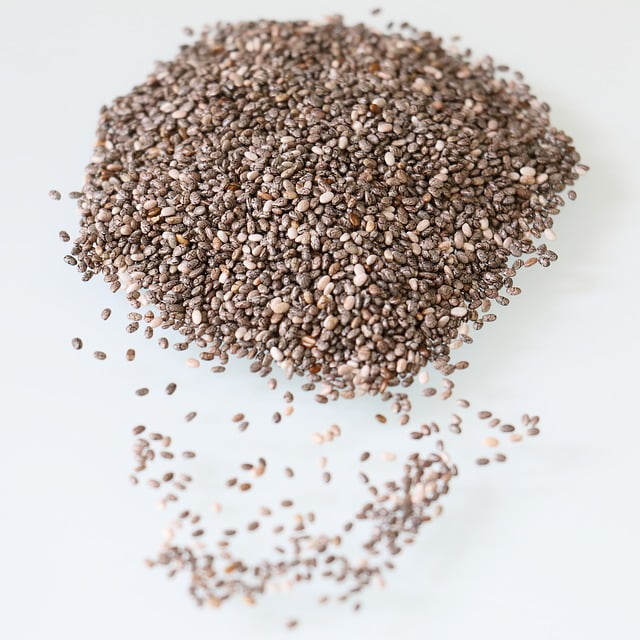
This will not be all the things that could be talked about for chia seeds, but it will be the most common and main things to know.
Let’s start!
Chia Seeds Basics
We’ll start with some of the most basic things to know about chia seeds next.
What are Chia Seeds?
Chia Seeds are tiny little black and white seeds that come from a desert plant in Mexico, Salvia hispanica, that’s in the mint family.
They’ve been eaten for thousands of years, even by the Aztecs.
Why Eat Chia Seeds?
Chia seeds are super nutritious for you, and we’ll talk about the benefits next. But there’s one thing that I really love about chia seeds, that make them super important for most people.
The answer is fiber.
You see, fiber is so important for our health and well-being. But the truth is, that 95% of American adults don’t get enough fiber!
You see, it’s not a lack of protein as so many become fixated on nowadays! It’s fiber. People get plenty of protein, even vegans or vegetarians, but hardly anyone gets enough fiber. And fiber is so essential to our health and our gut health and microbiome.
So why chia seeds? Chia seeds are loaded with fiber! They are actually the highest-fiber food I’ve ever found.
In fact, just 2 tablespoons of chia seeds pack a whopping 11 grams of fiber, or a third of the daily recommended value for men and half the value for women! Whoa!
Plus, they come with other benefits as well.
Apparently, not only are most Americans deficient in fiber as I mentioned previously, but they also don’t get the recommended daily intake of Omega-3s! (See how to get plant-based omega-3s at How I Get My Plant-Based Omega-3 Fatty Acids!)
The good news is chia seeds pack a whole day’s worth of ALA Omega-3s in just 1-2 tablespoons.
Benefits of Chia Seeds
As we talked about already, chia seeds are loaded with fiber. But that’s not all.
They are also packed with Omega-3 fatty acids. Americans also don’t get enough of these. And chia seeds are one of the highest sources of Omega-3s.
Also, chia seeds have tons of antioxidants. Basically, these are things that fight off stress and oxidative damage that can lead to cancer and more.
So chia seeds (as well as other plant-based foods) can fight cancer as well.
Learn more about all the over 30 benefits of chia seeds here.
Chia Seeds Are Easy to Eat
Another thing I love about chia seeds is they are easy to eat. You can incorporate them into your diet in different ways.
Ways to Eat Chia Seeds
There are a few ways that you can eat chia seeds. (You can learn many different ways at How to Eat Chia Seeds)
First, you can just eat them raw. You will still get the fiber from eating the chia seeds raw, but a preferred way of eating them is either by soaking them first or grinding them. This increases their digestibility and nutrient uptake.
We will talk about the different ways to eat chia seeds next, and after that, we will learn how to prepare them for each method.
Raw Chia Seeds
For raw chia seeds, you don’t have to prepare them. Because chia seeds have no taste, you can easily just sprinkle them on top of anything you might be eating (and that they might go well with!)
So, that could be on a salad for example. (Here are the chia seeds I use here. And here is another chia seed option that I highly recommend.)
Another easy thing to do is to add some chia seeds to baked goods or anything you are preparing. But don’t go crazy because it could change the consistency with too much!
Also, did you know that you can use chia seeds in place of eggs in baking? Yep, it’s called a chia egg. It’s just 1 tablespoon of chia seeds and 3 tablespoons of water per egg being replaced. (Chia egg recipe here)
Soaked Chia Seeds
Soaking chia seeds is probably the most common way to prepare them. This basically means allowing them to sit in a liquid such as water or milk (a plant-based milk works) until they soak up the water and expand, creating a chia gel.
You see, chia seeds can absorb something like 19 times their weight in water. So when placed in a liquid, they swell up and create this interesting kind of gel. Now you probably don’t want to eat the water-soaked gel by itself, but we’ll talk about ways to use it in the next emails.
So why do we want to soak the chia seeds? The chia seeds in the gel will be somewhat soft now. The process of soaking them has kind of started the digestion process and helped to break down their protective barrier.
Now we can absorb them better. In fact, a recent study showed an increase in the amount of ALA found in the bloodstream by eating soaked chia seeds. Another study actually found NO CHANGE in ALA levels when eating raw chia seeds.
This means that we may need to soak chia seeds (or use the next method) in order to be able to absorb the Omega-3s. (ALA is the name for plant-based Omega-3s) It’s also possible that other minerals or antioxidants might not be absorbed as well either unless the chia seeds are either soaked or ground first.
You can view more info on the studies or why we should soak chia seeds in my post at Do You Need to Soak Chia Seeds?
Ground Chia Seeds
Grinding chia seeds is my new favorite method to prepare chia seeds, after having soaked them for years. This is because a study showed that ground chia seeds dramatically increased ALA and EPA levels in the bloodstream.
You can learn more about this at Ground Chia Seeds vs Whole – Which is Better?
The ground chia raised the ALA levels by 58% after only a short period of time. This was higher than the soaked chia seeds in the other study.
But in fairness, these were two separate studies. To really compare them, they should be compared head-to-head in the same study with the same variables.
EPA levels also increased, meaning that the ALA was being converted to EPA. This is good because this is what people are trying to get when they take fish oil supplements.
Also, I’ve found that grinding chia seeds is actually slightly easier. Although, soaking chia seeds is not difficult at all.
Preparing Chia Seeds
Next, we will learn how to prepare chia seeds by either soaking them or grinding them!
(Raw chia seeds need no preparation)
Soaking Chia Seeds
Soaking chia seeds is pretty easy! You can learn how to do it in my post, How to Soak Chia Seeds where I go into more detail. I also have a short video here where I show how as well.
Basically, you are just going to mix tablespoons with water (or milk), using a ratio of around 1:4 or 1 tablespoon of chia seeds to 4 tablespoons of water.
You just mix or stir them together and let it sit for 15 minutes. Then stir or mix again and store covered in the fridge. It should last for at least 5 days, and sometimes longer. (We’ve eaten it over 5 days before. But it’s easy to make, so just make smaller batches so it won’t sit too long in the fridge.)
Some people will use a mason jar, screw the lid on and then just shake in order to mix the chia seeds and water together. Works the same.
Grinding Chia Seeds
Grinding chia seeds is pretty easy as well! In fact, you can now buy chia seeds that have already been ground if you prefer. (You can find Ground Chia Seeds here)
But you will pay more for pre-ground chia seeds. (We’re frugal so I use the raw chia seeds I linked to earlier) So if you want to grind your own, here is how I do it.
Really you just need the right blender or a spice grinder or coffee grinder. Any one of the spice grinders or coffee grinders found here should work.
That’s because spice grinders or coffee grinders are designed to chop up seeds, spices, or beans very finely. So they should work.
You can also do it with the right blender, but not all work. I’ve tried some that didn’t.
The one that worked for us, happened to be one we already had. It’s the Nutribullet Baby Blender. Seems that it works for more than just baby food!
Chia Seed Recipes
Here are some recipes in which you can use chia seeds, either ground up, soaked, or raw.
You can find a full list of our chia seeds recipes here.
Healthy Oatmeal with Chia Seeds
One of the first ways we started using chia seeds, was in our breakfast oatmeal bowl. I would soak the chia seeds ahead of time, then add them into the bowl of oatmeal, along with some other nutritious things like hemp seeds and flax seeds.
(This site right here has an awesome selection of all these seeds and more at the lowest cost!)
Here you can find my super healthy plant-based breakfast oatmeal bowl with chia seeds recipe!
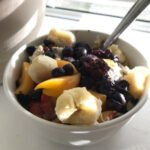
You might also want to try chia seed cereal. The recipe post is below, however, it is a little more involved to make than chia seed oatmeal.
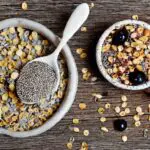
Chia pudding is a very interesting treat! It’s basically just soaked chia seeds but in milk instead of water. (We use a plant-based milk like soy or almond milk)
Basically, the chia seeds thicken in the milk creating a pudding-like texture. (Instead of the gel you get with water)
If you use sweetened plant-based milk (which a lot are) then you probably don’t need to add any extra sweetener. Otherwise, you can just add a little bit of honey or maple syrup (a tablespoon would probably be fine, depending on your taste).
Some will even add extra ingredients such as vanilla (to make a vanilla pudding) or cocoa (for chocolate), and I’ve even seen cinnamon and other interesting spice combinations!
Here’s a simple 2 ingredient chia pudding recipe.
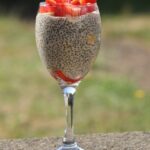
Chia water is basically what the name sounds like. Chia seeds in water!
But instead of soaking them to create a gel, you use fewer chia seeds to make water that you can drink. You can drink this throughout the day or whenever you want, to help get some chia seeds in your day. (See How to Use Chia Seeds for Weight Loss)
Here’s the recipe for easy chia seed water.
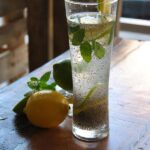
How Much Chia Seeds To Eat Per Day
I answer this question in detail in How Much Chia Seeds Should I Eat?
But just to give a quick summary, here’s what it is.
It somewhat will depend on your goals and also how healthy you already are eating each day. For example, if you are already getting a lot of fiber in your diet because you eat a lot of other plant-based, clean and healthy foods, you probably won’t need as much chia seeds per day.
If you are someone who is struggling to eat healthy, and really needs more fiber, or you are trying to lose weight, then you might want to eat more chia seeds per day.
For someone eating healthy, you probably want to try to get around 1-2 tablespoons of chia seeds per day.
For someone who isn’t eating as healthy, you might want to increase that to around 4 tablespoons. You could go higher, but just remember, that’s a lot of fiber, so be careful!
My main advice is to start with 1 tablespoon when you first start eating chia. See if your body can handle the extra fiber.
One of the main problems I had when I first started eating more plant-based, is my stomach would get upset at night. I found that this was common, and probably due to the increase in fiber.
Your body isn’t used to the fiber and can’t digest it very well yet. But it will build up the right good bacteria until it can.
It just takes a little time. For me, after about a month I was ok.
So anyway, start with 1 tablespoon of chia seeds per day. If your stomach is ok, then increase that by 1 tablespoon and see how you feel.
Keep doing that till you hit your goal amount.
Do You Need to Soak Chia Seeds in Warm Water?
No. You can soak them in cold water or warm water. (I cover this here in detail.)
I would avoid hot or boiling water though. As this might destroy the nutrients.
I would also try to avoid cooking them as much as possible as I explain in this article.
How Long Do Chia Seeds Last?
Unlike most seeds that can go rancid, chia seeds have an antioxidant that protects them from going bad for quite a while. Really, they have a shelf life of a couple of years.
If you know how to store them you can increase that.
Learn more including the best ways to store chia seeds at How Long Do Chia Seeds Last? In the Pantry, Water or Fridge?
How to Store Chia Seeds
I cover this in detail here, but you can extend the shelf life of chia seeds.
If you store them in the pantry, keep them out of light and not too hot, and keep them dry. They will last for quite a while here.
If you want to have them last even longer, and maybe even retain more nutritional value, store them in the fridge or freezer.
You can add a couple of years to their shelf life in the fridge, and up to 5-10 years in the freezer.
What Are the Best Chia Seeds to Buy?
All chia seeds should be roughly the same. Here are the ones I get, they are organic and have the best value.
Another good-priced one that is a great price is found here at Nuts.com. But these are not organic.
Final Thoughts
Hope you were able to gain a lot of info from this chia seeds guide!
Lance has been passionate about the plant-based diet and we have been following a whole food plant-based diet for over 5 years. We focus on health, natural healing, weight management, animal rights, and the health of the planet and environment by focusing on whole plant-based foods and sustainable practices.
Learn more at the About Me page and follow on social media at the links below.

